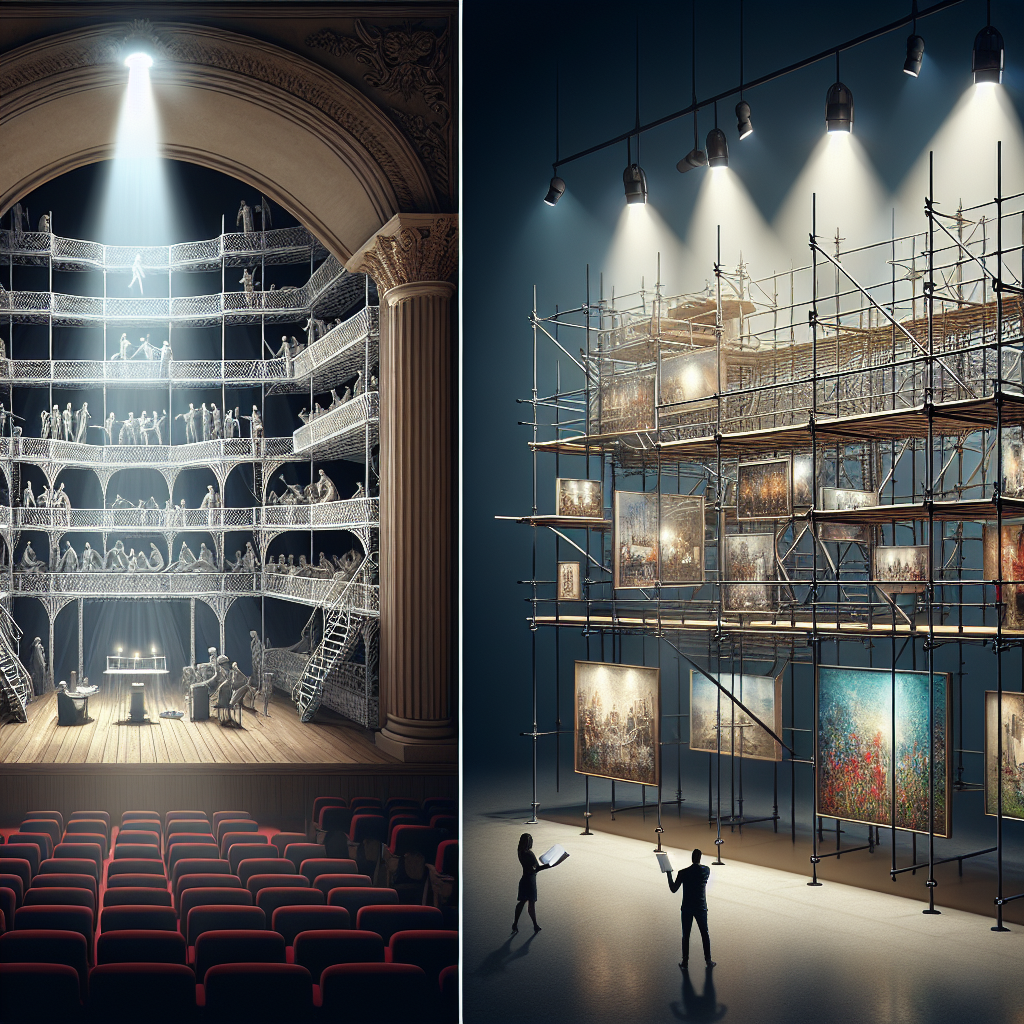
Introduction
In the world of theater and arts exhibitions, innovation is often a key driver of success. One of the most dynamic tools available to creatives is scaffolding—not merely as a physical structure, but as a conceptual framework that empowers artists to elevate their work. The phrase "Scaffolding for the Arts: Creative Uses in Theatrical Productions and Exhibitions" conjures images of intricate structures that support the artistry, creativity, and collaboration that bring stories to life and engage audiences. This article will explore how scaffolding can be creatively used in theatrical productions and exhibitions, offering unique insights and reimagined approaches that can revolutionize the way we view the arts.
The Foundation of Scaffolding
Understanding Scaffolding in the Arts
Scaffolding, in a literal sense, provides temporary support during the construction of a building. In the arts, it serves a similar purpose, facilitating the development of ideas, collaboration among artists, and the realization of ambitious projects. This support allows creatives to explore, fail, learn, and ultimately thrive within their artistic endeavors.
- Metaphorical Scaffolding: Artists often require frameworks—both physical and conceptual—to help them build their works. This involves the structured yet flexible support that can be adjusted as needed, allowing for innovation.
The Importance of Scaffolding in Theatrical Productions and Exhibitions
The key to successful theatrical productions and exhibitions lies in collaboration, experimentation, and adaptability. Scaffolding provides these essential elements, offering a foundation to explore new themes, narratives, and technologies. By incorporating scaffolding into their creative processes, artists can unlock new dimensions of their work.
Creative Uses of Scaffolding in Theatrical Productions
1. Physical Scaffolding: A Multi-functional Tool
Physical scaffolding has long been employed in the construction of stages. Its versatility allows for the creation of complex stage designs and environments for performances.
Case Study: The Bridge Theatre’s "Young Marx"
The Bridge Theatre in London utilized scaffolding to enhance its production of "Young Marx." The structure allowed for multiple levels of performance, creating various layers for the cast to interact with the audience. This innovative use of physical scaffolding contributed significantly to the play’s dynamic nature.
Analysis: This example illustrates how scaffolding enhances both visibility and engagement in theatrical productions, providing actors with creative spaces to experiment with staging elements while ensuring alignment with the narrative.
2. Creative Collaboration: Building Community Through Scaffolding
Theater is fundamentally a collaborative art form, where the synergy between actors, directors, and designers creates compelling stories. Scaffolding can be employed as a framework for collaboration, ensuring all voices are heard and creativity is maximized.
Case Study: The Royal Court Theatre’s "Theatre Uncut"
In 2011, "Theatre Uncut," an initiative by the Royal Court Theatre, demonstrated how scaffolding can facilitate collective creativity. Plays were developed in response to socio-political issues, with contributors adding their perspectives and ideas. The project exemplified the scaffolding of community inputs fostering diverse voices.
Analysis: The Royal Court’s initiative showcases scaffolding not just as a structure, but as an approach to harness the collective genius within the artistic community.
3. Technological Scaffolding: Bridging Innovation and Tradition
As technology evolves, so too do the opportunities for innovative storytelling in the arts. Digital scaffolding—using technology to enhance the artistic framework—transforms how narratives are presented.
Case Study: "Sleep No More"
The immersive theatre experience "Sleep No More" utilizes digital technologies as scaffolding for its intricate storytelling. Through the use of augmented reality and interactive elements, audiences engage with the narrative as participants rather than passive viewers.
Analysis: This example illustrates how technological scaffolding enriches traditional storytelling forms, enhancing audience engagement and creating immersive experiences.
4. Thematic Scaffolding: Structuring Narratives
Thematic scaffolding provides artists a way to build meaningful narratives. This process involves creating layers of meaning that resonate with audiences on multiple levels.
Case Study: "The Vagina Monologues"
Eve Ensler’s "The Vagina Monologues" represents a powerful use of thematic scaffolding. Through individual stories, the play explores universal themes of womanhood and empowerment, allowing for varied interpretations and dialogues.
Analysis: This case shows how thematic scaffolding enables works to transcend boundaries, creating conversations that resonate deeply within different communities.
Creative Uses of Scaffolding in Exhibitions
5. Curatorial Scaffolding: Structuring Art Experiences
In exhibitions, curatorial scaffolding plays an essential role in guiding audiences through complex narratives within galleries. Curators can utilize scaffolding to contextualize works, facilitating a richer understanding.
Case Study: "The Armory Show"
At New York’s "The Armory Show," curators employed scaffolding to link contemporary themes with historical contexts. The exhibition paired modern works with classical pieces, encouraging viewers to draw connections and reflect on the evolution of art.
Analysis: This approach to curatorial scaffolding demonstrates the potential for exhibitions to narrate deeper stories while elevating audience engagement.
6. Spatial Scaffolding: Reimagining Gallery Spaces
Spatial scaffolding involves the reconfiguration of gallery layouts to enhance engagement and interactivity. This creative structure invites visitors to explore art in new ways.
Case Study: The Tate Modern’s Turbine Hall
The Tate Modern regularly transforms its Turbine Hall, showcasing large-scale installations using spatial scaffolding to frame the experience. Artists like Olafur Eliasson have created immersive installations that encourage exploration and participation.
Analysis: The transformations in this space highlight how spatial scaffolding can reshape how audiences experience art, making exhibitions more dynamic and interactive.
7. Environmental Scaffolding: Art in Context
The surrounding environment can serve as scaffolding for artistic expression, providing context that informs the reception of artworks. Artists can use environmental elements to craft immersive experiences.
Case Study: Christo and Jeanne-Claude’s "The Gates"
The installation of “The Gates” in Central Park presented a stunning example of environmental scaffolding. The orange fabric pathways transformed the park, creating a dialogue between nature and art and engaging with visitors on a sensory level.
Analysis: This case underlines how environmental scaffolding can amplify an artwork’s impact, transforming a familiar place into a stage for exploration and dialogue.
Integrating Scaffolding into the Creative Process
Techniques for Implementing Scaffolding
Workshops and Brainstorming Sessions: Host collaborative workshops to encourage brainstorming and cross-disciplinary dialogues among artists. This establishes a shared scaffolding of ideas.
Iterative Prototyping: Like constructing with actual scaffolding, use a prototype approach to test new ideas. Iterative processes allow for rapid adjustments that enhance creativity.
Feedback Mechanisms: Create structured feedback loops where artists can share their work in progress and receive supportive input, ensuring a collaborative scaffolding environment.
Interdisciplinary Collaborations: Foster partnerships across different areas of the arts, encouraging various perspectives that can enrich the creative framework.
- Utilization of Technology: Leverage digital platforms for collaborative design and feedback, allowing artists to scaffold their ideas in innovative formats.
Conclusion
Scaffolding for the Arts: Creative Uses in Theatrical Productions and Exhibitions demonstrates that the possibilities for innovation are immense. From physical structures that support performances to thematic frameworks guiding narratives, scaffolding acts as an essential ally for artists seeking to elevate their work. By embracing the potential of scaffolding—both literally and conceptually—artists can push the boundaries of creativity, foster collaboration, and create transformative experiences.
To maximize the creative potential of scaffolding, artists should experiment with these techniques in their practice. Whether it’s transforming a stage, reimagining gallery spaces, or constructing narratives with layered themes, the effective use of scaffolding can lead to groundbreaking artistic endeavors that resonate with diverse audiences.
FAQs
1. What is scaffolding in the context of the arts?
Scaffolding in the arts refers to both physical structures and conceptual frameworks that support creative work, collaboration, and innovative storytelling.
2. How can scaffolding enhance audience engagement in theater?
By providing dynamic structures and layers for interaction, scaffolding encourages audiences to engage more deeply with the performance, transforming them from passive viewers to active participants.
3. Can scaffolding be applied to visual arts exhibitions?
Absolutely! Curatorial and spatial scaffolding can enhance the visitor experience in exhibitions by guiding narratives and encouraging exploration.
4. What are some examples of technological scaffolding in theater?
Technological scaffolding includes using augmented reality, digital storytelling techniques, and interactive elements to enrich performances and engage audiences.
5. How can artists implement scaffolding in their creative processes?
Artists can implement scaffolding through collaborative workshops, feedback mechanisms, iterative prototyping, interdisciplinary collaborations, and the use of technology to enhance creativity.
By embracing scaffolding in creative practices, artists can unlock new realms of possibility, making their work resonate more profoundly in a world that thrives on innovation and connection.















